Previously I wrote about the Tadpole Paper Mill and the Stockphoto Paper Mill papers. Paper Mills are companies that sell fake or plagiarized scientific papers to authors who need them for their career. Certain countries have strict requirements or monetary incentives for medical doctors, graduate students, or other researchers to publish papers. In such countries, other researchers or business folks have found creative ways of making money by selling fake papers to researchers. Such paper mills are similar to essay mills where ghostwriters offer their services to undergraduate students.
Paper mill papers sometimes can be recognized because they are written based on templates or by recycling the same photos. A particular set of papers might contain the same remarkable typo, western blots with the same background, similar title structures, the same erroneous gene sequence, unrealistic flow cytometry plots, or recycled electron microscopy photos.
Other paper mills operate by working together with journal editors responsible for ‘special issues’ who will review and accept low-quality submissions where authors have been added for payment.
Countless hours have been put into finding such linked sets of papers by volunteers such as Smut Clyde, Tiger, Jennifer Byrne, Jana Christopher, and Anna Abalkina. Here, we will look at a slightly different paper mill.
A new paper mill involving plants sampled in Iran
A tweet by Norbert Holstein, @dr_norb, led to a set of papers describing plants collected in Iran.
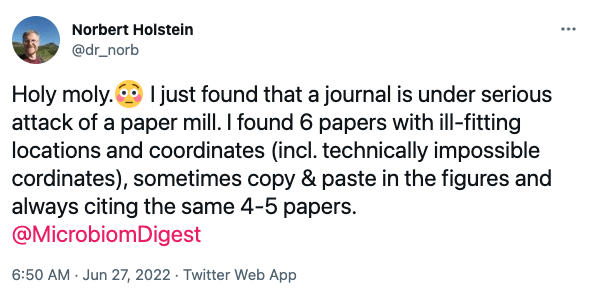
The “Iranian Plant Paper Mill” [Google Sheets – 57 70 papers as per September 2022] contains plant sampling locations that are shared between papers. Although the coordinates are the same across papers, the names of the locations (cities, provinces, regions) as well as the researchers or plant species vary. If one does a Google Scholar search on ‘altitude 165 159 1133 1139 2383 Iran’, there are 40 results, many of which might be from the same paper mill. The locations given in the table usually do not match those given on the map that is included in many of the papers, although both are showing Iran.
In addition, the locations often including impossible latitudes and longitudes, such as 38 ̊52’93” latitude and 47 ̊25’92” longitude. In these examples, the last number is seconds, so it cannot be higher than 59.
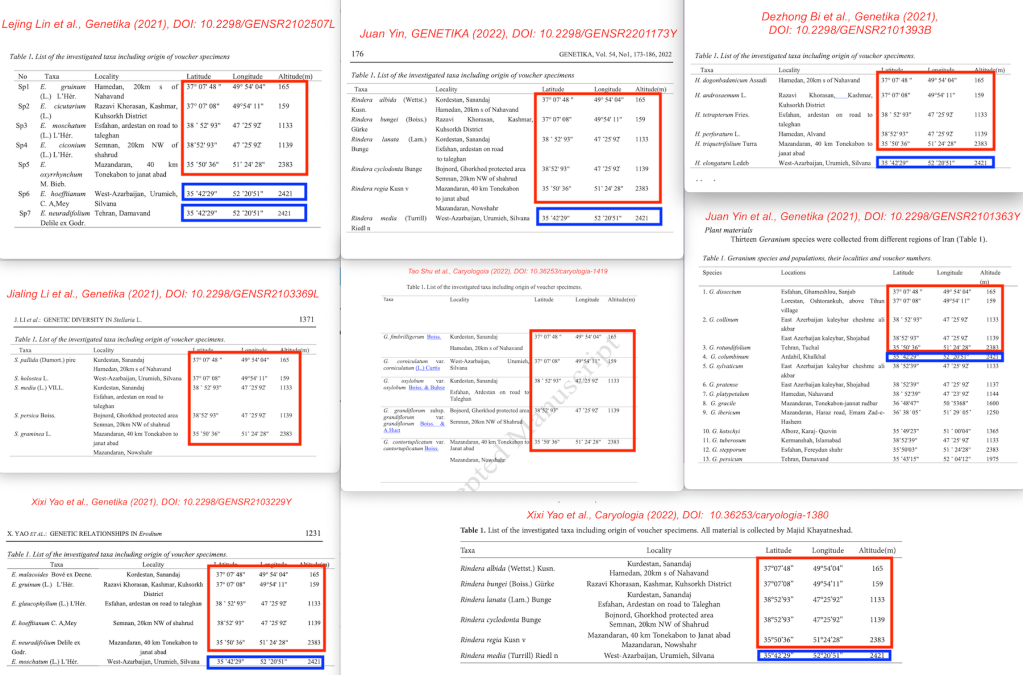
Science ‘detectives’ Hoya camphorifolia, Stericta loxophaea, and Scythris inertella (pseudonyms) found many more similarities between these papers, such as shared TCS networks or phylogenetic trees. This is quite unexpected, given that these papers had different sets of authors analyzing different plant species.
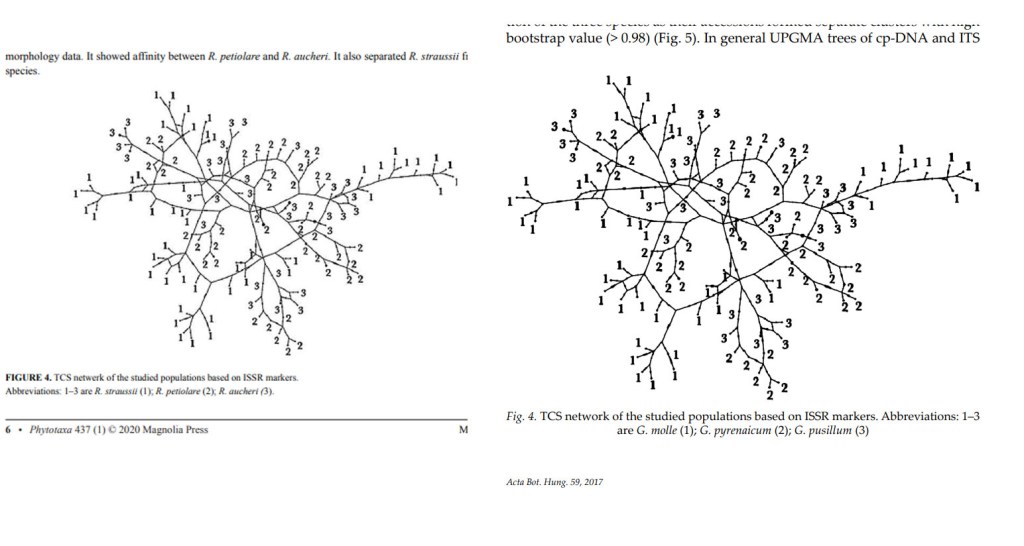
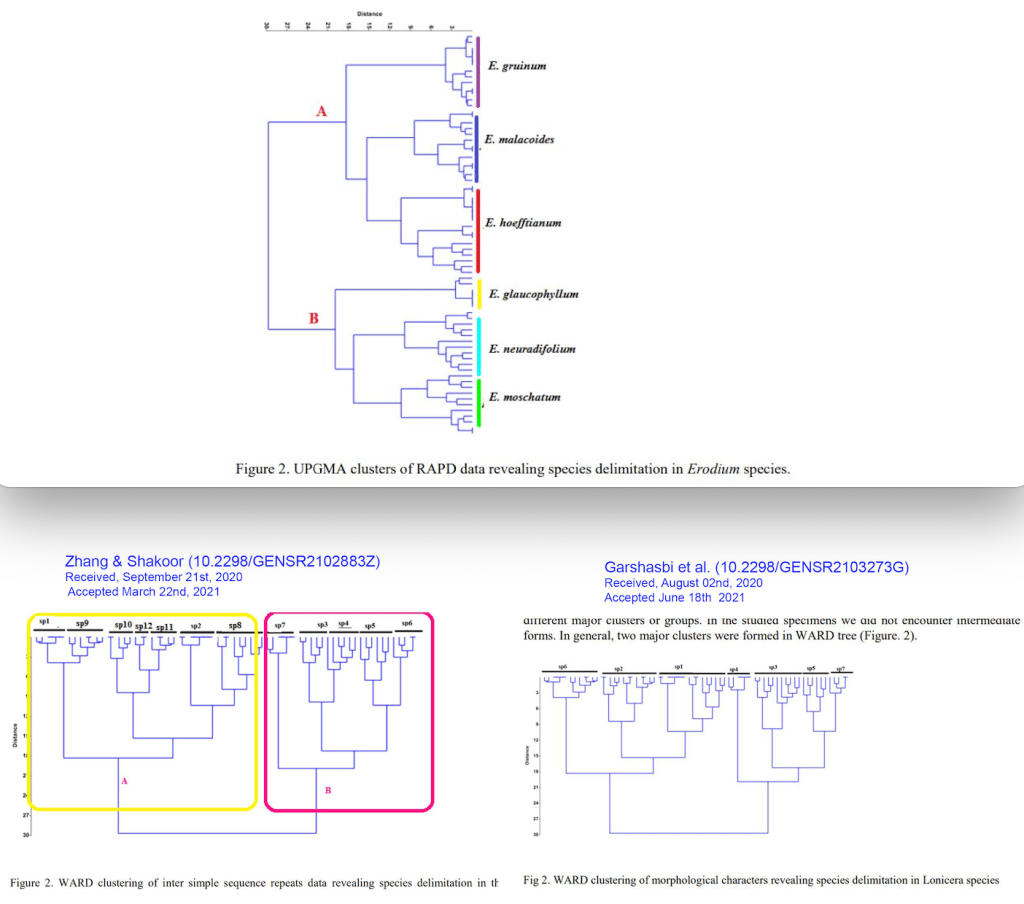
Several of these papers contain agarose gels with duplicated or altered lanes, which are sometimes re-used in other papers.
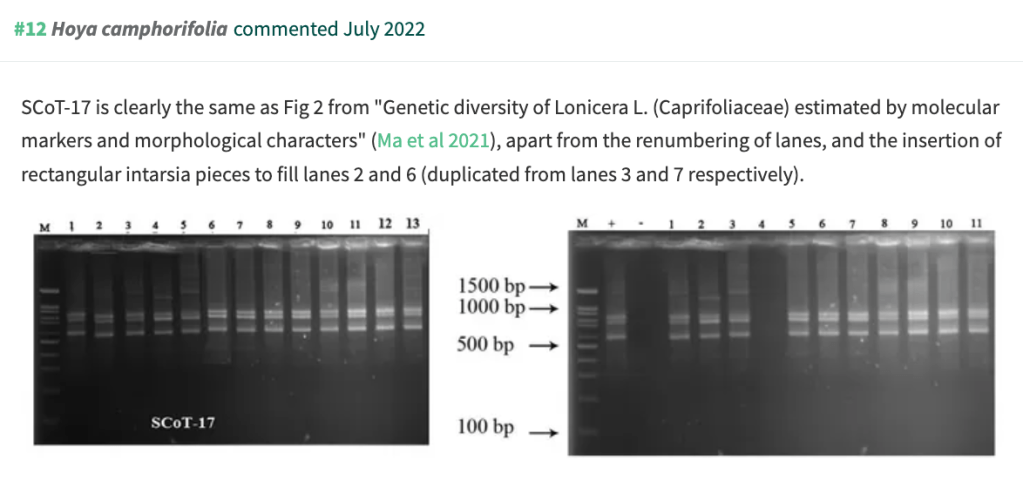
Other papers in this set contain tables with the same genetic distances values found in other papers in this set, as illustrated in the screenshot below. What are the chances that different groups of researchers working on different plants using different sets of primers would all find the same genetic diversity values?
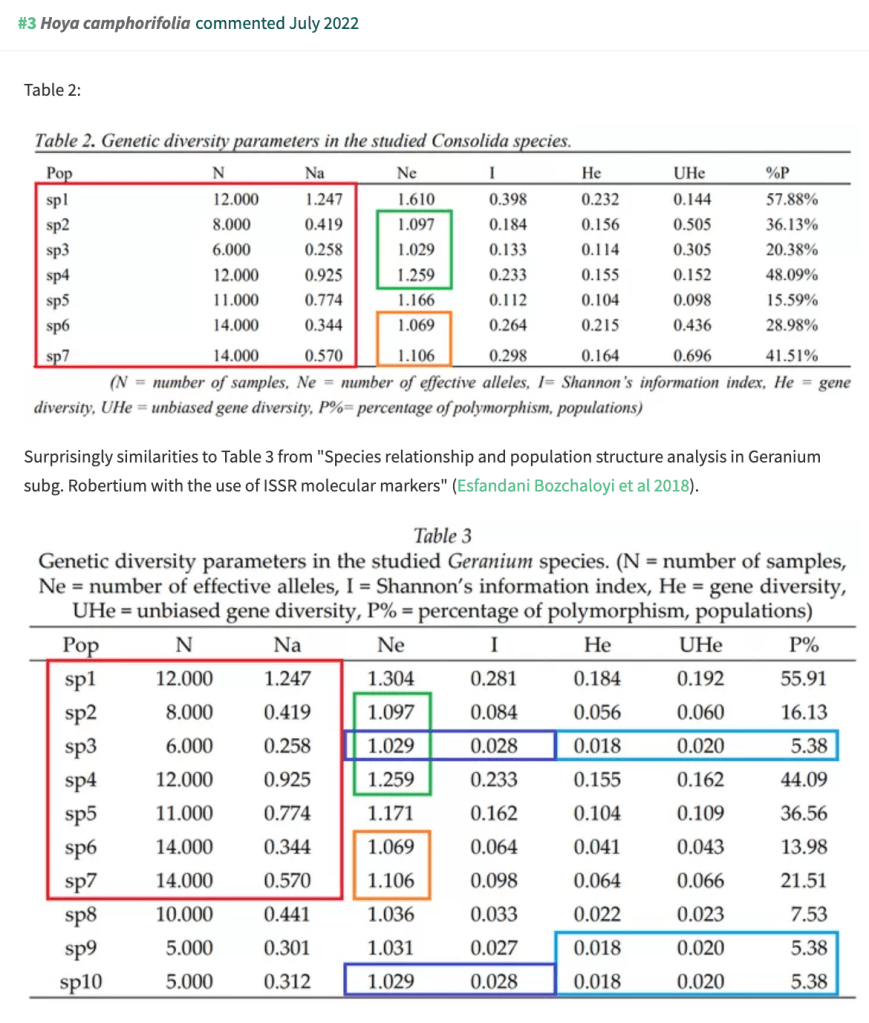
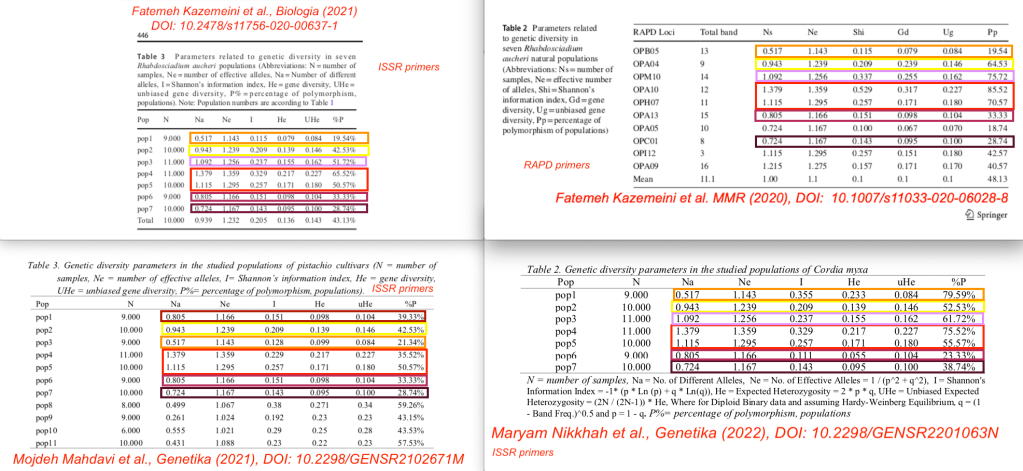
The first and corresponding authors are primarily from China, from different institutions, with co-authors from Iran. The corresponding email addresses do not always match the corresponding author’s name.
Paper mill AND citation ring
Many of these papers seem to have in common citing the same papers by S.M. Esfandani-Bozchaloyi and M. Khayatnezhad, perhaps as part of a citation ring.
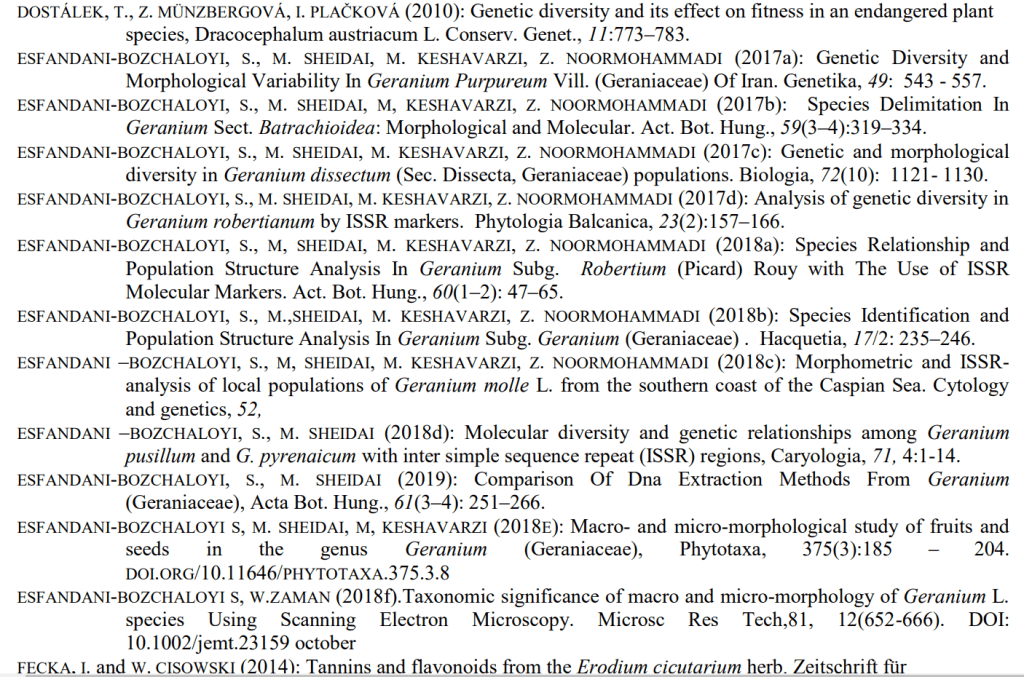
The topics of these citations do not always belong in the papers citing them, suggesting that the paper mill might have been set up not only to sell papers, but also to increase the citation index of these authors.
Following papers that cite older papers by Esfandani-Bozchaloyi or Majid Khayatnezhad might lead to several more members of this set. I will update the numbers as I am finding more of these.

Dear dr. Bik,
What if this “papermill” is actually a tiny low-quality corner of a larger operation?
Let me mention that Majid Khayatnezhad had some common papers with a well-known PubPeer character Afshin Davarpanah.
Or that the same Khayatnezhad is eagerly cited by a certain Kazakhstani guy called Alibek Issakhov (just check his output and co-authorships).
LikeLiked by 1 person
Correction: I was too eager to associate Issakhov directly to Khayatnezhad. In fact, they are associated through a spectacular batch of nano-trash published in “Applied Nanoscience” – see here for citations to Khayatnezhad:
https://scholar.google.com/scholar?hl=en&as_sdt=0%2C5&q=%22khayatnezhad%22+source%3A%22applied+nanoscience%22&btnG=
and here for Issakhov’s masterpieces in the same venue:
https://scholar.google.com/scholar?hl=en&as_sdt=0%2C5&q=author%3A%22issakhov%22+source%3A%22applied+nanoscience%22&btnG=
The name of MM Selim clearly stands out in both searches, but does not cover everything.
LikeLike
I think you have already found the link between Iranian, Chinese authors, and the editors (S. M. E.-B.).
The mill works this way:
1. They write papers for those PhD candidates that are not able to write in English properly. They get the money and data, fill the gaps by graphs and some additional data, and usually cite their own publication(s) to enhance their own citation index.
2. They send emails to different authors and offer them citation enhancement and authorship for money.
LikeLike
Dear Dr. Bik,
I am a science writer for the Israeli daily newspaper Haaretz. I couldn’t find another way of writing you, so I do it here. I am writing on the subject of scientific fraud. If you don’t mind, I will very much appreciate you contacting me.
Many thanks in advance
LikeLike
Dear Gidon, I have sent you an email. Thank you for contacting me.
LikeLike
Hello Dr Bik
Published in socarxiv.
Recommendation for dual peer-reviewing in science journals supported by two interpretations of Jacques Derrida’s critical thinking and not so-tiring queries of Michel Foucault
AUTHOR
Ramasubramania Iyer
https://osf.io/preprints/socarxiv/f3bgc/
Since , Prof Roald Hoffmann’s Derridean interpretation was used in the paper , emailed him for comments . His comments and critique are available in the attached pdf in research gate below first paper. .
https://www.researchgate.net/profile/Ramasubramania-Iyer
Your comments and critique will be highly appreciated. .
LikeLike
Hi Dr Bik
I’m a reporter at the Los Angeles Times and I’d like to interview you regarding recent news involving Stanford. Please let me know how I can reach you.
Best
Christopher Goffard
Los Angeles Times
LikeLike
Dear Dr. Bik,
There is another data fabrication and or paper mill by two researchers (Fraidoon Kavoosi and his wife Masumeh Sanaei) from Iran. There are a huge overlap in different sections of their papers.
Could you please see their profile and papers in google scholar.
Fraidoon Kavoosi:
https://scholar.google.com/citations?user=wo3tSNQAAAAJ&hl=en
Masumeh Sanaei:
https://scholar.google.com/scholar?hl=en&as_sdt=0%2C5&q=Masumeh+Sanaei&btnG=
Best Regards,
Mobina
LikeLike
Elisabeth Margaretha Bik
Elisabeth Margaretha Bik just read your publication
Article · PKCε Deficits in Alzheimer’s Disease Brains and Skin Fibroblasts
See your stats
Hi Elisabeth,
My name is Tapan Khan (email: khantapan67@gmail.com). Let me know if you find anything wrong in this article. I am the first and corresponding author. One peripheral Alzheimer’s disease test is developed based on this article. We regularly reproduced skin fibroblast results. It works now for Alzheimer’s disease diagnosis.
LikeLike
Hi Tapan, I do not have access to this paper. Can you share it with me, please?
LikeLike
See attached. -Tapan
LikeLike
https://osf.io/preprints/socarxiv/edkjg/
Cervantilitis during coronavirus times , madness then and now
Cervantilitis describes the unusual social behaviour of responsible citizens during coronavirus times. Tilted windmills, giants, and lance( or s) from “The Adventures of Don Quixote” by Miguel De Cervantes are in “emergence,” confusing the commoner. Madness then (Cervantes era ) and now ( age of science and reason ) are compared in this short communication.
Tsunami of journal publications and misinformation . How to tackle this ? . Disruptive science is not possible if this continues.
LikeLike
Apparently, this story ended in… absolutely nothing. Sad, but not at all a surprise.
LikeLike